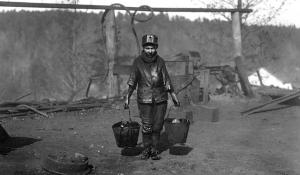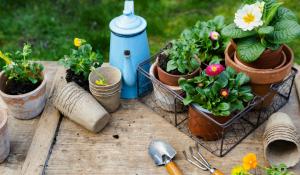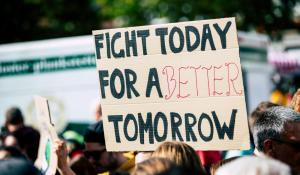
Queer leaders are making healing happen—healing for humans as people find a place to connect in safe spaces in nature, and healing for the Earth as thinkers come together for creative solutions to the climate crisis.
By connecting people with nature and inclusive communities, emerging outdoors groups are creating connections which can lead to fulfilling personal goals and being able to reflect on bigger issues too. At the same time, other queer groups are starting with the big picture and working inward, to see how resilience and creativity already within their communities can heal our earth.
Why Queer Justice is Climate Justice
Struggles against oppression are intertwined—people left out of support systems and oppressed by systemic injustices face the greatest threats in the climate crisis. Along with people living in poverty and people of historically disenfranchised racial and ethnic groups, queer people will and do face disproportionate burdens from natural disasters, polluted air, and unstable housing.
Not being accepted by family, feeling tokenized at work, or being left out of a social group is indicative of the systematic discrimination that queer people and especially queer people of color face. LGBTQ+ people are overrepresented in the unhoused population, particularly in youth, and in the prison system, with lesbian, gay and bisexual people being incarcerated at three times the rate of straight people, according to the Prison Policy Initiative. Trans people are incarcerated at even higher rates.
Reducing CO2 emissions and bringing down the global temperature will disproportionately benefit people living in poverty, unhoused people, and incarcerated people, and the queer people represented in those groups along the way, even more than the general population. That means LGBTQ+/queer justice is climate justice.
"[Queer people] have been great at adapting in urban communities, and it’s going to be our resilience in non-urban communities, communities that are more integrated into the ecological system, that’s going to be able to allow us to thrive and be a part of the [climate] solution.”
—Layel Camargo, Shelterwood Collective
Why Community is Important
At their office, Jas Maisonet didn’t feel like they fit in. As a nonbinary person with brown skin at a largely white company, they wondered if they were a diversity hire, and if they were getting paid what they were worth for their work as a graphic designer. Maisonet wondered if they were the only one feeling this way, but didn’t know who to talk to about it. An avid outdoorsperson since childhood, Maisonet had been part of hiking groups in the past, but not any that made them truly feel seen. That’s why they started QPOC Hikers [i.e. Queer People of Color] after settling into a new home in Seattle, Washington.
It turns out they weren’t the only one feeling isolated—Seattle has grown into a tech hub where white men have an easier time fitting in at work or in social spaces. Maisonet found their people in nature. They started the group in 2019, so most of the group’s outings at this point have been during the pandemic—which complicated matters but didn’t stop the group. If anything, it grew.
The work done on the trail by QPOC Hikers community members is subtle but vital—and it’s not just about hiking.
Maisonet was inspired by the StoryCorps project, which facilitates conversations and storytelling between families and community members. As they navigate the trails on day hikes or backpacking weekends, QPOC Hikers also find a safe place to talk about handling feeling tokenized at work or where to get a haircut for curly hair. They also make space for story sharing for people who are not able to hike together in person online at qpochikers.com.
“I wanted to bring that element to the space of if there’s an experience that you love, or maybe that wasn’t so pleasant, that you’ve had on the trail, and you want to share that with other folks, maybe because you feel like you’re the only one going through something,” says Maisonet. “It’s a therapeutic space as well.”

Across the country in Atlanta, Georgia, Eileen Pagán was also looking for their people. Pagán is a queer, trans, nonbinary, first-generation American with Puerto Rican heritage who spent their childhood often with bare feet on the beach in Puerto Rico marveling at the ocean and hiking back at home in Florida. Pagán says queer, Latinx, and fat hikers like them often feel excluded, stigmatized, or even in danger when outside in nature.
Pagán got word of a new hiking group in their area, called Latinx Hikers, which was a community designed to be inclusive of people of all genders and sizes.
“It was one of the first times that I went on a group hike where I didn’t feel like I was bringing the group hike down because of my own accessibility,” Pagán says.
Pagán works as a trauma counselor and art therapist and says it’s no coincidence that nature has healing properties for humans—that if people are able to feel safe in nature, whether with a community or by themselves, there can be healing outdoors.
“I found connection and reconnection to being outside and being a part of this earth because I resemble so much of what I love,” Pagán says. “I feel so attached to the mountains, like the vastness of the valleys, and the way that they all connect to each other, and how unapologetically they take up space. Finding that connection to the Earth was really important for my own healing process of my body—destigmatizing that for me, and finding healing in that.”
Queer Protectors of Nature
In Cazedero, California, pine trees, oaks, and Douglas fir trees give shade to cabins and trails—the area is serene and popular for camping and hiking. As wildfires threaten the dry West year after year, Cazedero is at risk. It’s going to take creative solutions to manage climate risks in forested areas like this.
Shelterwood Collective is working on it. The nonprofit group, started by Nikola Alexandre, Layel Camargo, and Sovereign-Xavier Oshumare, intends to bring land healing and community healing together in this small town. The nonprofit venture they started will bring together their perspectives as queer, Black and Indigenous people, along with other members of queer and communities of color, to model how ecosystems can be healthier when they are stewarded by people who shed colonialist conservation principles.
It sounds complicated, but at its core, it’s about resilient, creative people working the land. Alexandre, who has a master’s degree in forestry from Yale University, will be leading the group’s forest-management efforts to restore historic redwoods to the area—he points out that in Western conservation methods, it is ignored that Indigenous people co-evolved with forest ecosystems as they stewarded them for the last 10,000 years.
“A lot of traditional land trusts and conservation organizations are very [cisgender-, hetersexual-], and white-dominated and bring a lot of that ethic into how they manage forests. You can often see the poor quality of land stewardship and conservation activities,” says Alexandre. “I was very interested to see how we could create a model of land stewardship that centers de-colonial, queer, and racially just land ethics.”
Camargo says during the worsening climate crisis, cultural preservation and unconventional resilience strategies will be necessary. They give the examples of using art, retaining Indigenous and immigrant languages, and learning about historic resilient, and natural practices from those communities as strategies that they hope to make space for thinking about and practicing at Shelterwood.
“I think Shelterwood is a hub for just being in right relationship with the land, with the pressures of climate change. As queer people, we had to build that for ourselves, because there weren’t land projects that are exclusively working to bring in some of the most marginalized people—which can be us,” says Camargo, a cultural worker who is transgender, gender non-conforming, and an Indigenous descendant of the Yaqui and Mayo tribes.

Looking for Your People
If you’re looking for community in an outdoors group, you might not be too far from the trail right now—try a search engine, social media, or asking a local LGBTQ+ support organization. Or you can be like Jas Maisonet, and be the organizer you want to see in the world.
Queer-, BIPOC-, and women-led land management is becoming more common too. Try searching for “queer-led land trust” and your state, or substitute for other historically underrepresented groups in land ownership.
Camargo’s emphasis on the preservation of queer, Black, Indigenous, immigrant, and other traditionally oppressed experiences as being key to survival in the climate crisis shows that so many activities can play a part in queer justice and climate justice—from an inclusive group taking walks and connecting in nature to growing their own food to taking on a land management project.
“[Queer people] have been great at adapting in urban communities, and it’s going to be our resilience in non-urban communities, communities more integrated into the ecological system, that’s going to be able to allow us to thrive and be a part of the [climate] solution.”







